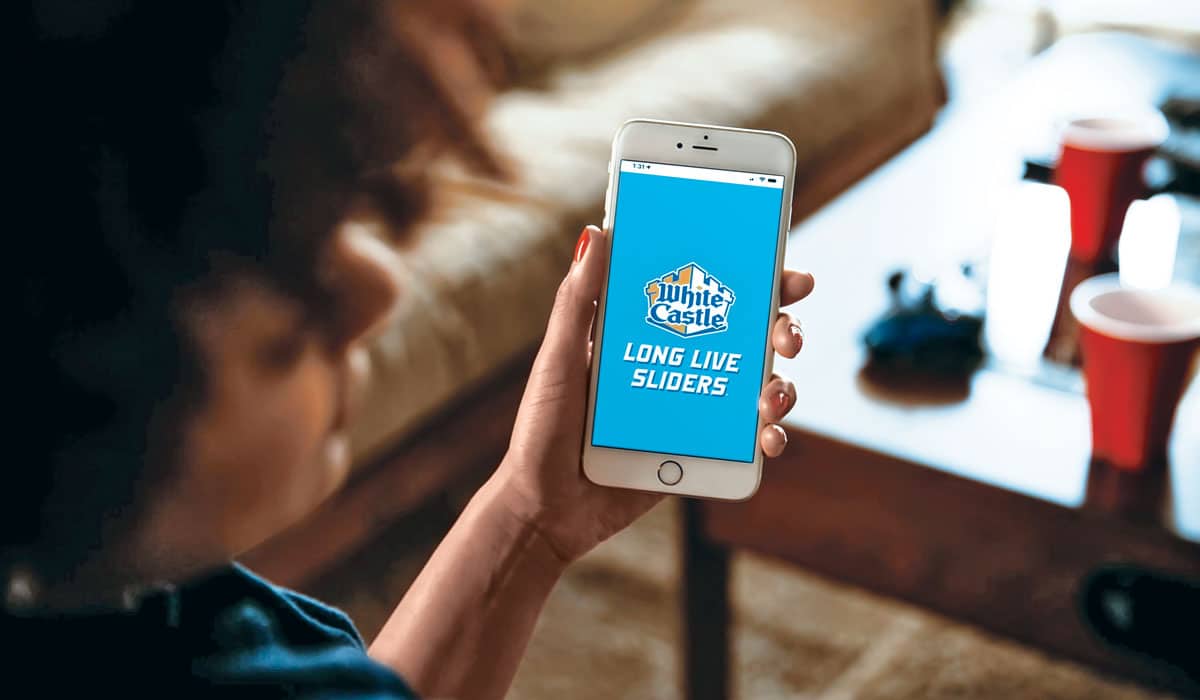It only took White Castle 99 years to get into the loyalty game. Now there, the slider-peddling chain intends to stay.
Fueled by empowering technology, consumers’ hunger for more personalized communications, and the ubiquity of mobile devices, White Castle began building its first loyalty program in mid-2019. COVID-19’s arrival in early 2020 accelerated those efforts, and White Castle launched its Craver Nation loyalty program systemwide last September.
“Our goal was to make a more direct line from our customers to what they crave,” says White Castle vice president Jamie Richardson, reminding that a similar philosophy guided the Ohio-based chain in 1927 when it stacked its sliders in bags and popularized restaurant carryout.
From the White Castle mobile app, customers can craft their order and select their preferred time and location for pickup. They can also access special Craver Nation offers and enjoy contactless payment for safety and convenience. “It’s the democratization of how we enjoy food,” Richardson says, adding that early returns on the loyalty program have “exceeded targets.”
Driving loyalty’s rise
White Castle, of course, is not alone in putting a target on loyalty. Some of the nation’s largest chains, including Wendy’s, Burger King, and McDonald’s, have recently invested in the loyalty game, while others—Domino’s and Starbucks among them—continue to strengthen and solidify their existing loyalty programs.
But it’s not just the quick-service heavyweights embracing loyalty. In its recent survey of 500 restaurants, merchant services company Square found that 42 percent of restaurants planned to invest in customer loyalty programs.
And for good reason. The pandemic accelerated consumers’ adoption of digital technologies as millions downloaded branded restaurant apps and ordered food through digital channels. Loyalty emerged as a powerful way for brands to engage with customers and capture sales at a vulnerable time. And loyalty programs delivered on that hoped-for revenue. In its January 2021 “Delivering on Restaurant Rewards” report, Paytronix noted that members of loyalty programs spent more than twice as much on takeout as did those who were not members of loyalty programs.
Loyalty programs also emerged an important defensive strategy amid surging digital adoption. Rather than ceding millions of potential customer data points to third parties, many brands doubled down on an internal loyalty program to ensure control of customer data. Domino’s Piece of the Pie Rewards, for instance, is climbing toward 30 million members, a vast database the chain actively leverages to improve service, increase frequency, and heighten results.
“With aggregators like DoorDash and Grubhub, brands are concerned about losing customer relationships,” says Shyam Rao, CEO at Punchh, a provider in customer loyalty and engagement solutions that works with the likes of Papa John’s and Yum! Brands. Rao adds that Wall Street is increasingly analyzing traffic growth and customer transaction count, not just sales. That has more brands eager to entice people to order more frequently, a prominent goal of any loyalty program.
“During the pandemic, people ordered more because behavior changed, but that isn’t necessarily sustainable because the average order check will decline at some point,” Rao says. “If traffic counts for existing customers—which is a proxy for loyalty—are growing, that’s a positive because it’s cheaper to retain a customer than acquire a new one.”
Loyalty’s table stakes
When White Castle began building its loyalty program, company leadership identified two necessary elements: It had to be easy to use and offer attractive incentives to spur customer engagement.
“Fall short of this and you’re creating more headaches and heartaches,” Richardson says.
The user experience is especially critical, Rao says. Making the transaction convenient, safe, and ubiquitous inspires what he calls “lifecycle loyalty.” By and large, he says consumers want an integrated experience—both in and out of the store—where they can order ahead, seamlessly accrue points, and capture offers tailored to them and their ordering history.
The user experience is also important on the operational side. In testing its loyalty program, White Castle not only examined ease of use for consumers, but also studied how its restaurant teams engaged with the app and how it integrated into their workflow.
The evolution of loyalty
Customer data is among the principal advantages of offering a loyalty program, an effective—and potentially profitable—social contract in which the customer willingly trades personal information for perks. As such, the ability to collect data and create actionable insights from the information is central to long-lasting connections with consumers and a brand’s larger marketing strategy, says Maggie Kelleher, director of business development at VAI, a developer of enterprise resource planning software.
“However, there is still room for improvement when it comes to utilizing technology to capitalize on quick-service loyalty programs,” Kelleher says. “As companies continue to utilize first-party data provided by consumers participating in loyalty programs, it is crucial to have a robust cloud solution at the backend to host this data and pull insights to further drive consumer loyalty.”
Absent this, a loyalty program exists, but might never thrive. Loyalty, after all, is “a means to an end,” Rao says, and that end is creating a deeper connection between customer and brand. “A brand with 1 million loyalty program users should effectively have 1 million loyalty programs,” Rao says.
Thereafter, brands can take the next step in engagement with secret tiers that unlock special menu items, swag, gamified experiences, or sweepstakes. They can also tie loyalty to social causes. For some members, this creates a more meaningful loyalty program that enhances their personal connections to the brand.
“By connecting loyalty programs to the rest of your marketing strategy,” Kelleher says, “companies can continue to build a trusting relationship with consumers to further drive sales and business growth.”











